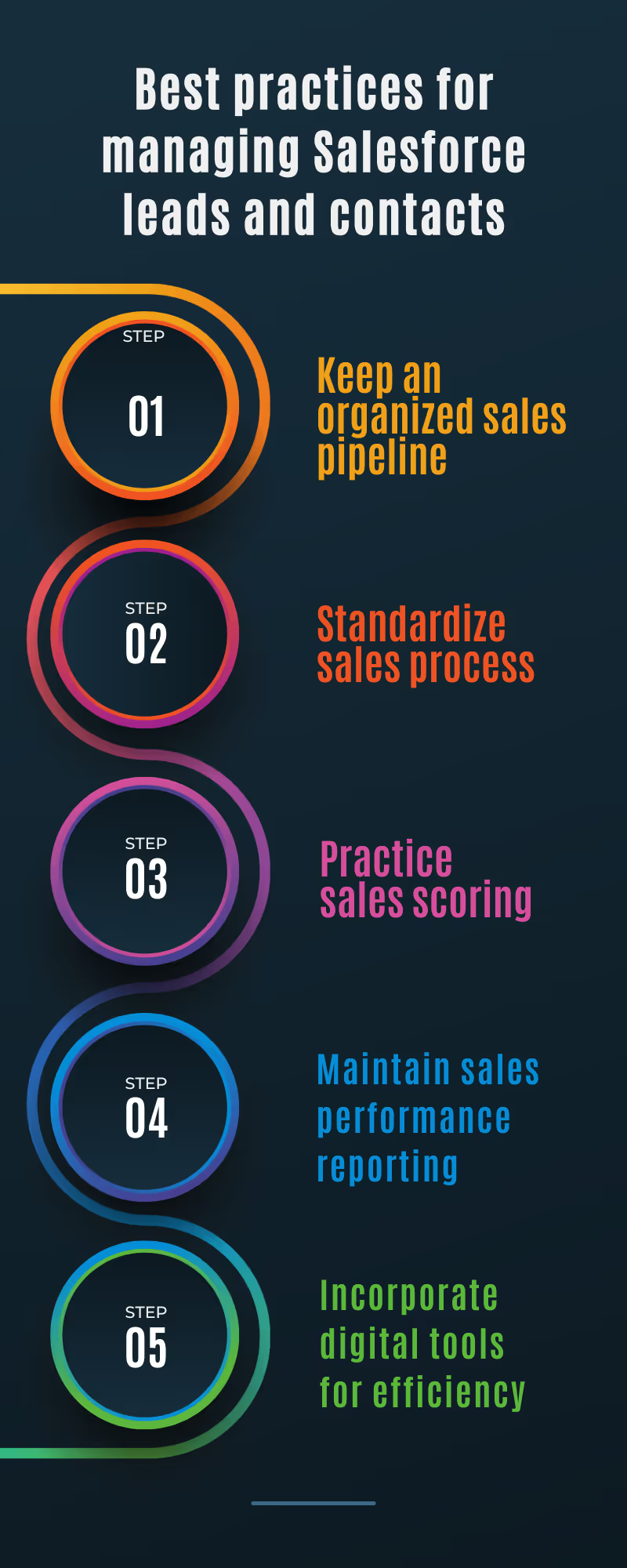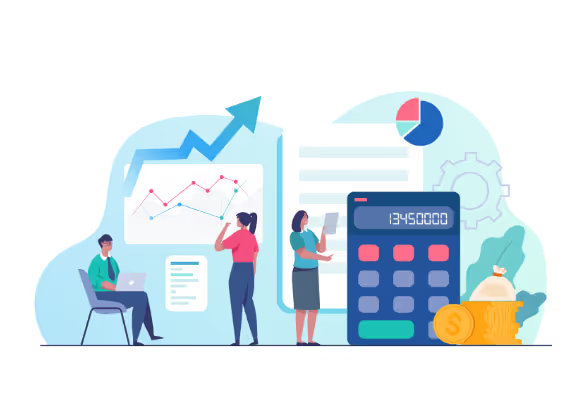
Blog
A Comprehensive Guide to Salesforce Leads and Contacts
June 5, 2023


Key Insights
Sales forces incorporate various tools, techniques, and strategies to efficiently keep their sales pipeline organized.
One such method is categorizing individuals and companies in their pipeline into leads, contacts, accounts, and opportunities.
Categorizing prospects into various types helps prioritize leads, strategize sales, and bring in an effective conversion rate in sales.
But what do these terms mean? What is the common confusion between a lead and a contact? What are the strategies for converting leads to contacts?
Let's find answers to these questions and more in this article.
So scroll down for more.
Understanding Leads and Contacts in Salesforce
Leads are the individuals and companies at the top of your sales pipeline. They are aware of your company and product but have never been approached for sales before. A lead is an unqualified prospect who the sales rep has yet to vet before they are considered a potential client.
A contact, on the other hand, is a qualified prospect. A contact, specifically, refers to an individual who can be a potential customer. They can be one among the many contacts a sales rep has towards selling their product to a prospective organization.
This potential organization in your sales pipeline is called an account.
While a lead who has decided to close a deal with you is defined as an opportunity.
With this understanding of the terms, let's know more about salesforce leads vs. contacts
Best practices for managing Salesforce leads and contacts

Since the difference between salesforce lead vs contact is very subtle, knowing best practices that can effectively differentiate the various prospects is important.
- Keep an organized sales pipeline
A sales pipeline is the most effective tool to understand your customer journey. Hence, keeping it organized with proper tagging of prospects and their journey will give a better understanding of the personalized strategies to be utilized to qualify a lead and ensure better conversion rates.
- Standardize sales process
Organizations must maintain a standardized sales process so that there is a consensus on the techniques and strategies that must be incorporated when coming across a lead and further.
- Practice sales scoring
In the realm of sales team roles, sales scoring encompasses the practice of assigning scores to qualified leads by the sales and marketing team, taking into account their likelihood of making a purchase. Leads with a greater probability of converting are bestowed with higher scores, thus enabling the sales team to prioritize their sales strategies accordingly. This approach ensures that the sales strategies employed for each lead are aligned with the scoring determined by the salesforce.
- Maintain sales performance reporting
A sales performance report is a document that contains information such as the number of sales, revenue generated, average sale price, customer acquisition cost, conversion rate, and other relevant sales data. With this information, managers can evaluate performance as well as make better-informed decisions for higher conversion rates.

- Incorporate digital tools for efficiency
Incorporating digital tools in marketing and customer management makes routine tasks efficient and effortless. Utilizing advanced sales acronyms and data-driven solutions are backed by data that seamlessly track leads and contacts, update their current status, and forecast their chances of conversion.
Strategies for converting Salesforce leads to contacts
Consistently, we have emphasized the significance of upholding a robust and well-structured sales pipeline. An integral aspect of achieving this is through the qualification of your prospects, a step that holds paramount importance. This process aligns with individual incentives, driving the motivation to effectively categorize and evaluate potential leads.
Understanding that a lead is a perfect profile to be your potential customer, as defined by MBO in sales, moves them to the contact stage. This ensures that there is a clear demarcation between your lead vs. contact in sales and that the efforts you put into sales strategies do not go astray.
So here are a few strategies to make that crucial step towards beginning your sales process.
- Research Your Leads
Lead generation is the most effort-requiring part of a sales process. Hence, the sales and marketing team must do the prospecting, evaluating, and segregating work seriously. Proper research into the profile of each lead is very crucial to ensure that no effort goes in vain during the entire sales process.
- Reach out to Valid Contact
Filtering and segregating the generated leads makes half the work done. Knowing who are the warm leads and cold leads helps prioritize your sales efforts. In addition, having the contact information of the right person to pitch your sales is also an important factor in determining sales effectiveness. If the first person of contact is the right decision-maker in this regard, the sales journey moves faster.
- Exploit Your Sales Scoring Data
Sales scoring is an effective metric to strategize and personalize your sales plan. The higher a sales score of a potential lead the more valuable and important they are as a contact. This means that they have a higher chance of becoming your potential customer and that you need to effectively plan your sales process.
- Lead Response Time
A potential lead already knows your brand. Once they have been determined as qualified prospects, the next important step is to contact them as soon as possible. The quicker you are in reaching out to your lead the higher your chances of conversion.
- Incorporate CRM tools
Digital tools are an efficient way to approach your everyday operations. Especially in the lead contact stage, Customer Relationship Management tools help you track your customer’s journey, automate email and social media campaigns, and personalize customer experience all backed by data to check the effectiveness of these measures in the sales process.
Analyzing Salesforce lead and contact data

Salesforce lead vs contact is a fine line but a clear demarcation between the two has a significant effect on your sales pipeline and process.
In the realm of sales compensation plans, having the knowledge of whether a lead in your pipeline is a potential contact significantly enhances your conversion prospects, establishes a clear outcome for your efforts, and enables you to strategically formulate a plan to capture your client's attention.
Finally, a lead vs contact differentiation also ensures a well-organized sales pipeline.
In addition to all these advantages at your disposal, salesforce leads vs contact also contribute to analyzing your sales and marketing performance. Qualifying a lead to contact is largely the responsibility of the sales and marketing team.
When steps like prospecting a lead, evaluating their profile, and determining if they are fit to be your ideal customer are done effectively at the beginning of the sales journey, it contributes a lot to the sales performance management.
Hence, directly and indirectly, contact vs lead in salesforce influence and determine the sales and marketing performance.
ReKennect : Stay ahead of the curve!
Subscribe to our bi-weekly newsletter packed with latest trends and insights on incentives.
Thank you! Your submission has been received!
Oops! Something went wrong while submitting the form.
Your data is in safe hands. Check out our Privacy policy for more info















